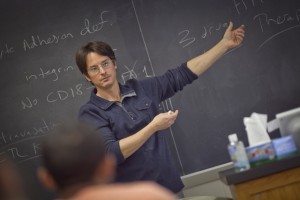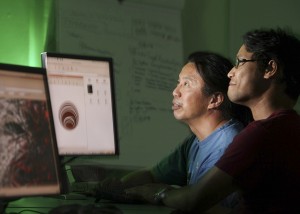
Robert Kurt, associate professor of biology, teaches a biology class in Kunkel Hall.
This spring, a new course combining biology and computer science will provide students with ways to build connections between disciplines and new techniques to approach difficult biological problems.
The course, Modeling-Based Applications to Biology, can be taken as an alternative to General Biology 102. Developed as a result of a Mellon Course Development grant, it will be taught by Robert Kurt, associate professor of biology, and Chun Wai Liew, associate professor and head of computer science.
The class will require that students learn roughly the same amount of content as General Biology 102, but through the process of problem solving.
“One driving force is that there is too much content to cover in a general bio course and so an alternative approach may be warranted,” says Kurt. “By having students learn content by working in teams to solve complex interdisciplinary problems, the hope is that they will get more out of this type of class than the traditional intro course.”

Chun Wai Liew, left, associate professor of computer science, works with Ashutosh Tamrakar '12 in Acopian Engineering Center.
Liew and Kurt will lead classroom discussions, showing the class how two different disciplines would view problems and how individuals can incorporate multidisciplinary approaches to problem solving.
The projects in the course are built around current events. One project will have students model the immune response to cancer and the other will have students isolate and model their own DNA.
“Our hope is that students will retain the content better with the approach we are using in the new course since they will have to learn material for the purpose of addressing specific problems,” says Kurt. “In addition, if students learn the process of solving interdisciplinary problems then they will be in a better position to take charge of their own learning.”
Liew is excited to provide students with a new learning opportunity.
“I am interested in guiding the students to learn how to approach solving interdisciplinary problems — which is what most interesting problems are,” he says. “They will learn a lot and enjoy the challenge.”


2 Comments
That is really creative and I think it will help in a long run trying to merge two different areas of knowledge. Way to go Lafayette!!
Comments are closed.